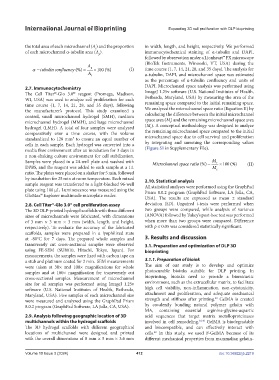Page 420 - IJB-10-3
P. 420
International Journal of Bioprinting Expanding 3D cell proliferation with DLP bioprinting
the total area of each microchannel (A) and the proportion in width, length, and height, respectively. We performed
t
of each microchannel α-tubulin area (A ). immunocytochemical staining of α-tubulin and DAPI,
p
followed by observation under a Lionheart™ FX microscope
A (BioTek Instruments, Winooski, VT, USA) during the
α −tubulinconfluency (%) = p ×100 (%) (I) time course (1, 7, 14, 21, 28, and 35 days). The analysis for
A t α-tubulin, DAPI, and microchannel space was estimated
as the percentage of α-tubulin confluency and units of
2.7. Immunocytochemistry DAPI. Microchannel space analysis was performed using
The Cell Titer -Glo 3.0 reagent (Promega, Madison, ImageJ 1.25v software (U.S. National Institutes of Health,
®
®
WI, USA) was used to analyze cell proliferation for each Bethesda, Maryland, USA) by measuring the area of the
time course (1, 7, 14, 21, 28, and 35 days), following remaining space compared to the initial remaining space.
the manufacturer’s protocol. This study examined a We analyzed the microchannel space ratio (Equation II) by
control, small microchannel hydrogel (SMH), medium calculating the difference between the initial microchannel
microchannel hydrogel (MMH), and large microchannel space area (M) and the remaining microchannel space area
i
hydrogel (LMH). A total of four samples were analyzed (M ). A conceptual methodology was designed to analyze
r
comparatively over a time course, with the volume the remaining microchannel space compared to the initial
standardized to 128 mm³ to ensure an equal number of microchannel space due to cell survival and proliferation
cells in each sample. Each hydrogel was converted into a by integrating and summing the corresponding values
media flow environment after an incubation for 3 days in (Figure S1 in Supplementary File).
a non-shaking culture environment for cell stabilization.
Samples were placed in a 24-well plate and washed with Microchannelspace ratio (%) = M r ×100 (%) (II)
DPBS, and the reagent was added to each sample at a 1:1 M i
ratio. The plates were placed on a shaker for 5 min, followed
by incubation for 25 min at room temperature. Each mixed 2.10. Statistical analysis
sample reagent was transferred to a light-blocked 96-well All statistical analyses were performed using the GraphPad
plate using 100 µL. Luminescence was measured using the Prism 8.0.2 program (GraphPad Software, LA Jolla, CA,
GloMax Explorer multimode microplate reader. USA). The results are expressed as mean ± standard
®
2.8. Cell Titer®-Glo 3.0® cell proliferation assay deviation (SD). Unpaired t-tests were performed when
The 3D DLP-printed hydrogel scaffolds with three different two groups were compared, while analysis of variance
sizes of microchannels were fabricated, with dimensions (ANOVA) followed by Tukey’s post-hoc test was performed
of 3 mm × 3 mm × 3 mm (width, length, and height, when more than two groups were compared. Difference
respectively). To evaluate the accuracy of the fabricated with p ≤ 0.05 was considered statistically significant.
scaffolds, samples were prepared in a lyophilized state
at -80°C for 7 days. The prepared whole samples and 3. Results and discussion
transversely cut cross-sectional samples were observed 3.1. Preparation and optimization of DLP 3D
using FE-SEM (SU8010, Hitachi, Tokyo, Japan). For bioprinting
measurements, the samples were fixed with carbon tape on
a stub and platinum coated for 2 min. SEM measurements 3.1.1. Preparation of bioink
were taken at 30× and 100× magnifications for whole The aim of our study is to develop and optimize
samples and at 100× magnification for transversely cut photocurable bioinks suitable for DLP printing. In
cross-sectional samples. Measurement of microchannel bioprinting, bioinks need to provide a biomimetic
size for all samples was performed using ImageJ 1.25v environment, such as the extracellular matrix, to facilitate
software (U.S. National Institutes of Health, Bethesda, high cell viability, non-inflammation, non-cytotoxicity,
Maryland, USA). Five samples of each microchannel size attachment and proliferation, and adequate mechanical
38
were measured and analyzed using the GraphPad Prism strength and stiffness after printing. GelMA is created
8.0.2 program (GraphPad Software, LA Jolla, CA, USA). by covalently bonding natural polymer gelatin with
MA, containing essential arginine-glycine-aspartic
2.9. Analysis following geographic location of 3D acid sequences that target matrix metalloproteinases
multichannels within the hydrogel scaffolds involved in cell remodeling. 39,40 GelMA is biodegradable
The 3D hydrogel scaffolds with different geographical and biocompatible, and can effectively interact with
locations of multichannel were designed and printed cells. In this study, we used F-GelMA because of its
40
with the overall dimensions of 8 mm × 5 mm × 3.6 mm different mechanical properties from mammalian gelatin-
Volume 10 Issue 3 (2024) 412 doi: 10.36922/ijb.2219

